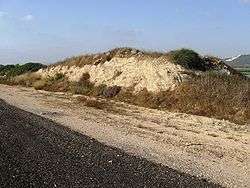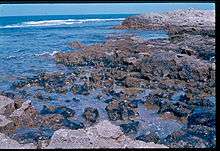Kurkar


Kurkar (Arabic: كركار /Hebrew: כורכר) is the term used in Palestinian Arabic and modern Hebrew for the rock type of which lithified sea sand dunes consist. The equivalent term used in Lebanon is ramleh. [1] [2] Kurkar is the regional name for an aeolian quartz sandstone with carbonate cement,[3] in other words an eolianite or a calcarenite (calcareous sandstone or grainstone), found on the Levantine coast of the Mediterranean Sea in Turkey, [3] Syria, Lebanon, Israel, [4] the Gaza Strip[5] and northern Sinai Peninsula.[6] The kurkar ridges are prevalent on Israel's coast from the area of Tel Aviv northwards.[4] South of Mount Carmel they form parallel alignments, the result of transgressive coastlines.[7] Kurkar is the product of windblown quartzitic sands which created dunes during the Pleistocene, [8] whose sand became cemented by carbonates which transformed it into sandstone (lithification process), giving birth to successive ridges along the shore. Kurkar occurs on the shore as well as under the current sea level, on the continental shelf. There are three underwater sandstone ridges off the coast of Israel and two on land.[9] The younger kurkar formations also build small islands or islets along the coast of Israel, Lebanon (at Sidon and near Tripoli), and Syria (Arwad).[7] In the Gaza Strip, coastal plain kurkar deposits of medium to coarse-grained calcareous sandstone are characterized by crossbedding.[5]
Israel's coastal sand dunes, the habitat of many rare species of plants and animals, are made of kurkar interspersed with hamra, red sandy loam. Until the beginning of the 20th century, Palestine (then under the Ottoman Empire) had 285 square kilometers of kurkar and hamra formations. Due to construction, farming and the use of off-road vehicles, this has diminished to 109 square kilometers.[10]
Kurkar ridges in Israel/Palestine provide nesting sites for an endangered species of bird, the European bee-eater; and nine species of wild plants native only to Israel, such as the coastal iris.[10]
In May 2009, an offshore pilot study was conducted in the northern Galilee by a team of scientists collecting geological, geophysical, geochemical and biological data in the vicinity of the Bustan Hagalil kurkar ridge. The ridge was mapped during the National Bathymetric Survey of Israel by multibeam sonar.[11]
See also
References
- ↑ [Nick Marriner, Christophe Morhange, David Kaniewski, Nicolas Carayon. Ancient harbour infrastructure in the Levant: tracking the birth and rise of new forms of anthropogenic pressure. Scientific Reports 4, Article number: 5554 (2014), doi:10.1038/srep05554 http://www.nature.com/articles/srep05554]
- ↑ [Aharon Horowitz. The Quaternary of Israel. Page 109. Academic Press, New York, 1979. ISBN 9780123561701. https://books.google.co.il/books?id=uT-0BQAAQBAJ&pg=PA109&lpg=PA109&dq=arabic+kurkar&source=bl&ots=jsSFmx-BO4&sig=a7zcZmxiJAoUMrqxs2u7f9u6fPQ&hl=en&sa=X&ved=0ahUKEwjCx7ynisrKAhWFkg8KHQwHCssQ6AEIODAG#v=onepage&q=arabic%20kurkar&f=false]
- 1 2 C.J. Brandon, R.L. Hohlfelder, M.D. Jackson, J.P. Oleson. Building for Eternity: The History and Technology of Roman Concrete Engineering in the Sea. Page 237. Oxbow Books, Oxford. 2014. ISBN 978-1782974208.
- 1 2 Francisc Dov Por. The Legacy of Tethys: An Aquatic Biogeography of the Levant. Pages 46-48, 54. Springer, New York, 1989, Monographiae Biologicae (Book 63), ISBN 9780792301899. "... around Tel Aviv ridges of aeolanitic sandstone ("kurkar") become prevalent. [...] Along the Lebanese and most of the Syrian coast, calcareous rocks alternate with kurkar ridges. [...] The vermetid platforms are especially well developed on the kurkar sandstones of the Israeli and southern Labanese shores...."
- 1 2 Palaeowind estimation of cross-bedding within the aeolian Kurkar layers of the Gaza Formation
- ↑ [List including 10 ancient inscriptions on kurkar stone found in Northern Sinai, at Ostrakine (El-Felusiyat) and near (?) Rinokoloura (El-Arish) http://www.trismegistos.org/tm/list.php?p=1814]
- 1 2 Maurice Schwartz (editor). Encyclopedia of Coastal Science. Page 74. Springer (Kluwer), Dordrecht, 2005, Encyclopedia of Earth Sciences Series, ISBN 9781402038808.
- ↑ Marine Sand Resources Offshore Israel
- ↑ Initial survey of the deep sandstone ridge off the coast of Israel
- 1 2 Disappearing sand dunes threaten rare flora and fauna
- ↑ Multi-disciplinary pilot study of the Kurkar ridges off Northern Israel Bustan HaGalil